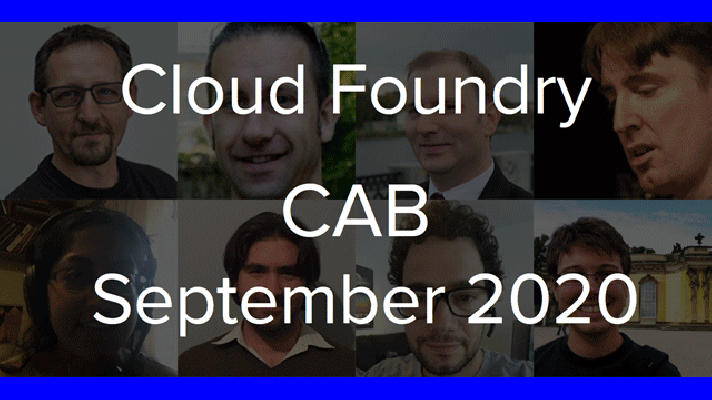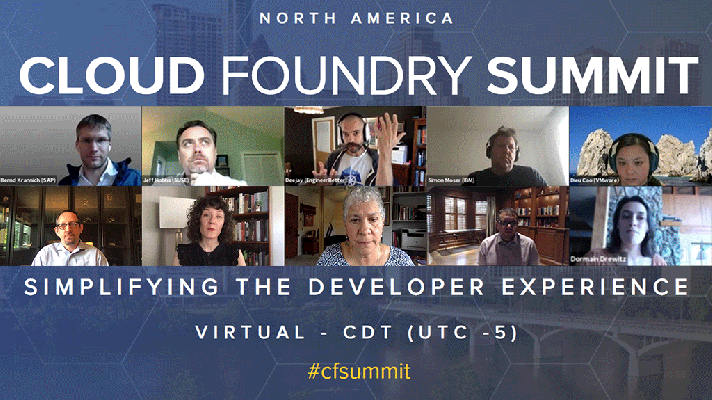Top Quotes from Cloud Foundry Summit 2021
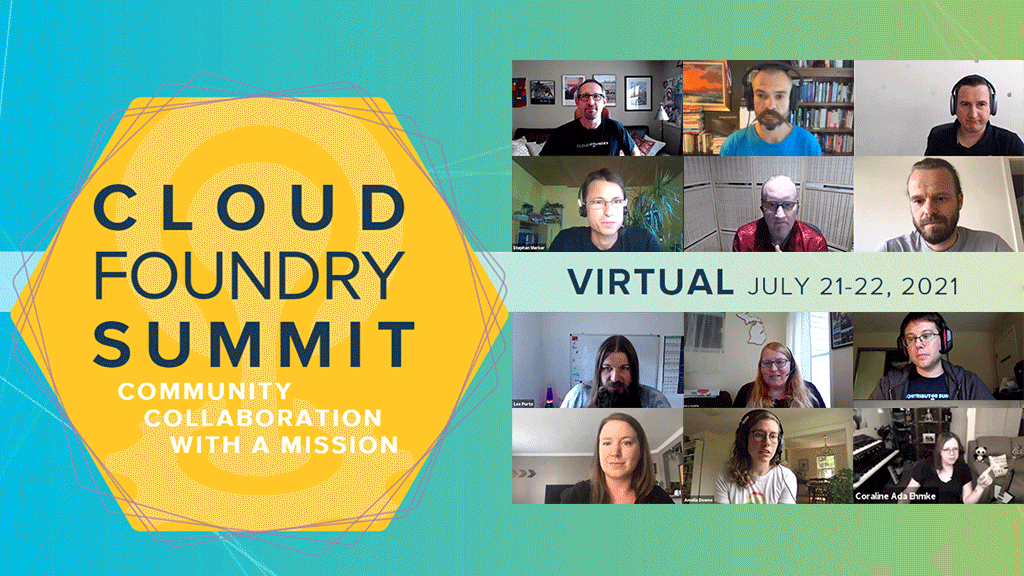
Major announcements
To keep everyone safe amid the ongoing pandemic, Cloud Foundry Summit 2021 was held remotely for the second year in a row. Chip Childers of the Cloud Foundry Foundation opened the virtual summit with a message of hope that we are slowly returning to normal.
“As we come out of a rather difficult year and a half, it may seem like we’re reaching a point where we’re in calm waters. In some sense we are, but we still have much further to go.” —Chip Childers, the Cloud Foundry Foundation
During the opening keynote, Chip announced the version 5 release of cf-for-k8s which combines the Cloud Foundry developer API with Kubernetes. The updated version includes:
- a new application support role for delegating app support responsibilities to dedicated personnel, without compromising developer ownership of the code
- support for the latest generation of Paketo Buildpacks
- an improved Istio service mesh upgrade process
- updated core Cloud Foundry components
- support for kpack v0.3.1, Istio v1.9.5, and Kubernetes clusters running v1.18 through v1.20
“If you haven’t looked at cf-for-k8s yet, I think now is a great time to take a look. Version 5 was recently released. Give it a shot. It should be a lot of fun and it makes development a lot easier on top of Kubernetes.” —Chip Childers, the Cloud Foundry Foundation
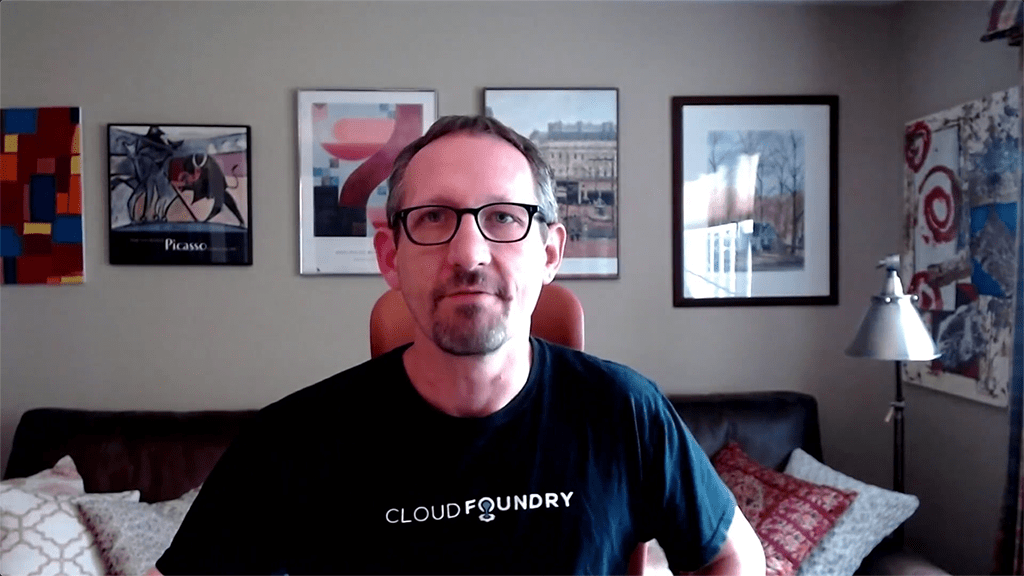 Chip Childers welcomes the virtual summit
Chip Childers welcomes the virtual summitChip also acknowledged several members who were awarded by the community for their contributions to the Cloud Foundry ecosystem. The awardees include:
- The Bionic Stemcell Project Team (Committed Contributor)
- Andrew Wittrock of VMware (Committed Contributor)
- Amelia Downs of VMware (Committed Contributor)
- Braunson Mazoka (Inspirational User)
- Ashley Gerwitz of Stark & Wayne (Awesome Advocate)
Before ending his keynote, Chip reminded the attendees that the Cloud Foundry ecosystem is constantly evolving. To be adaptable, new and existing projects need to follow suit. “Projects need to have change baked into their DNA,” he stressed. “The ability to navigate change in the open-source world as a community is something we’ve demonstrated time and time again.”
“We’ve always talked about the need to embrace change. This is something our community has espoused to end-user companies for many years. Frankly, it’s something we have a long history of doing.” —Chip Childers, the Cloud Foundry Foundation
All the major announcements from the summit can be found in the foundation’s press release.
Technical Oversight Committee updates
Earlier this year, the first-ever elections for open seats on the Technical Oversight Committee were held. Some of those who were recently elected shared their thoughts about the community restructuring and how the new system will be more accessible.
- “The fundamental change we’re making is moving away from project groups and having four PMCs that sit above the project group areas to having a single Technical Oversight Committee and eight different working groups underneath that. The working group themselves will have a larger remit in terms of projects that fall within their sphere, but it should make changes across multiple different components of Cloud Foundry a lot easier.” —Lee Porte, GOV.UK
- “I’m looking forward to this new approach, because it would make it easier for us to join, contribute, and maybe even become a committer, which was impossible in the past.” —Stephan Merker, SAP
- “From the perspective of people who’ve been driving the community for a long time, we want to make it way easier for all the organizations that are invested in and have contributed to the Cloud Foundry projects to have natural, convenient channels to contribute that don’t have that high barrier to entry.” —Eric Malm, VMware
- “As a current PMC lead for networking, I’ve just been leading this small little area of networking. I’m excited about the smaller number of groups, because rarely you do a feature that just touches on networking. It might touch the Cloud Controller, Diego, networking, or Garden. Having smaller logical groups will help us to work better together.” —Amelia Downs, VMware
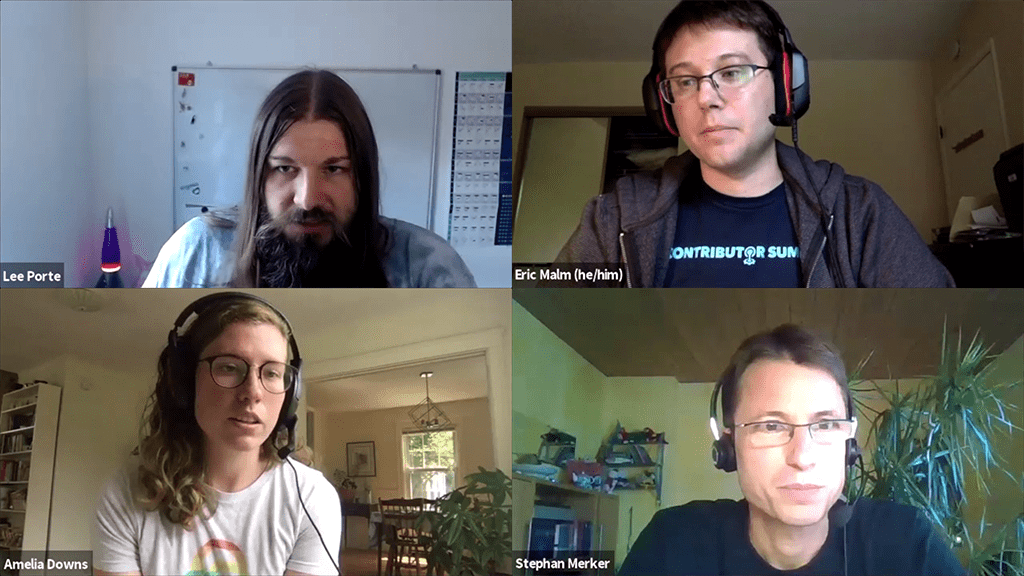 Lee Porte, Eric Malm, Amelia Downs, Stephan Merker
Lee Porte, Eric Malm, Amelia Downs, Stephan Merker- “Everything we do is around three key principles: transparency, clarity, and inclusivity. We’re making sure everything is open, transparent, and as clear as we can possibly make it, so we can actually help the community grow.” —Lee Porte, GOV.UK
- “We want to make sure we’re open for everybody from people of SAP or VMware down to developers working away in their bedrooms. We want to encompass all.” —Lee Porte, GOV.UK
- “This working group model opens up the community. The dojo experience is no longer there. Project plans, backlogs, and so on are moved to GitHub and can be seen.” —Stephan Merker, SAP
- “We’re getting rid of the dojo approach in order to become a member of a team. This was something that was a really good onboarding experience, but it made it inaccessible to smaller companies and individual contributors, because it required a very heavy time investment. Instead, we’re looking for regular activity within the different components that interest individuals in order to gain that access.” —Lee Porte, GOV.UK
- “One of the important roles that the Technical Oversight Committee is going to play here is in setting those baseline expectations around open process and consistency across the working groups. Each group will have their own amount of latitude in determining what kind of process they want to use for the scope of their responsibilities. We want to make it easy for someone who’s in the community or just entering to adopt practices whether that’s around GitHub issues and projects as the open mechanism, to get visibility into project activity and roadmap, but to have that portable across working groups.” —Eric Malm, VMware
For more details about the Technical Oversight Committee, watch their latest discussion, which was published today.
Kubernetes adoption
Many organizations running Cloud Foundry have adopted Kubernetes already. During the virtual summit, the community members discussed the advantages in each of the two platforms and the issues on the journey of Kubernetes adoption.
- “Giving our developers the power of
cf pushmaximizes their enablement. It creates an environment where they can have faster development cycles. We reduce their overhead and their frustration. Productivity increased significantly because of the ability tocf pushand make changes quickly.” —Kerry Schaffer, OneMagnify - “By adopting the Cloud Foundry platform, we’ve improved our security, because we can patch more frequently. The fact that we can do it through automation, and we can patch during business hours means we don’t have to wait and do a quarterly patch cycle.” —Kerry Schaffer, OneMagnify
- “Choose Cloud Foundry over Kubernetes if you already have a Cloud Foundry environment and it works.” —Julian Fischer, anynines
- “Go for a new Cloud Foundry installation if you have 12-factor–compliant workloads to run, and you want to increase productivity and decrease operational overhead.” —Julian Fischer, anynines
- “Having a centralized application development platform is one of the strong arguments for Cloud Foundry. Environments can become big. Infrastructure is agnostic, and you have one across the globe. There’s your unified application developer experience.” —Julian Fischer, anynines
- “If
cf pushworks for you, and you have a global set of developers who write applications that fit that model, Kubernetes would add more operational overhead to the developers.” —Julian Fischer, anynines - “If you’re migrating workloads from virtual machines to containers, Kubernetes could be your friend.” —Julian Fischer, anynines
- “Cloud Foundry is open-source. It’s not just a brand, it’s a community.” —Martín Valencia Flores, anynines
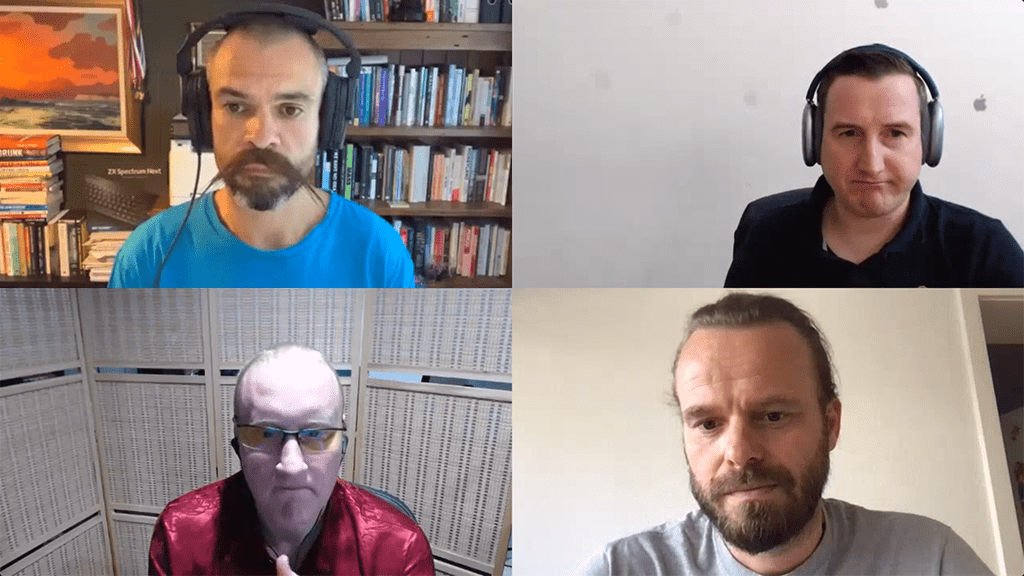 Daniel Jones, Julian Fischer, Wayne Seguin, Matthias Haeussler
Daniel Jones, Julian Fischer, Wayne Seguin, Matthias Haeussler- “If you need freedom and extensibility, and your team has the ability to deal with additional operational responsibilities, go for Kubernetes.” —Julian Fischer, anynines
- “It will take some time to solve the interoperability problems that come with Kubernetes, whether Cloud Foundry is involved or not. There are some underlying problems in the Kubernetes ecosystem. For example, how do you do intercluster networking properly? There are solutions to this, but they are not trivial and may or may not involve commercial vendors. You also have to look at the overall cost and effort for this package that does something similar compared to a classic Cloud Foundry stack for environments of a similar size.” —Julian Fischer, anynines
- “The concept of multitenancy that we have on Cloud Foundry is a solved problem. It scales wonderfully and it’s tried and true. With Kuberentes, instead of having one large problem to deal with, you have many smaller problems to deal with if you’re trying to accomodate for multitenancy factors.” —Wayne Seguin, Stark & Wayne
- “This time last year, I was gearing up the organization to be fully riding the Kubernetes hype train, but then this year, loads of Cloud Foundry work. I wasn’t expecting that at all. We’ve got more Cloud Foundry work that we can do. People keep on coming to us asking for it, but no new adopters. We’re talking to people who are already invested heavily in it, people who are already using it, and people who want to migrate away from it.” —Daniel Jones, EngineerBetter
- “I get exposed to lots of organizations that are using Kuberentes at scale who are pleading with their app developers not to push Redis clusters and ZooKeeper clusters and they’re saying, ‘Can you please only push 12-factor apps?‘” —Daniel Jones, EngineerBetter
- “A platform team that we were working with recently said everybody’s crying out for a Heroku-like solution for Kuberentes and I’m like where have I heard of something like that before? I’m sure someone’s built this already.” —Daniel Jones, EngineerBetter
- “Very often, we get asked by clients who say, ‘We want to build up this Kubernetes infrastructure to deploy applications and migrate applications from legacy to cloud.’ In general, I always say that most often, having Kubernetes is better than not having Kubernetes, but it is not as easy and friendly in handling compared to the experience with Cloud Foundry.” —Matthias Haeussler, Novatec
Starting your Cloud Foundry journey
Although Cloud Foundry was released in 2011, a decade ago, there are still organizations who are interested in the cf push experience. Longtime members of the community shared words of advice to help new companies and their development teams adopt or migrate to Cloud Foundry.
- “Ensure the availability of a mentor or, at the very least, have really good documentation at the ready, because newcomers are really going to need it.” —Martín Valencia Flores, anynines
- “Keep the onboarding focused to a certain set of skills.” —Martín Valencia Flores, anynines
- “You need to automate as much as you can upfront both at the platform management side and the development [to] deployment side. That’s how you get consistent outcomes.” —Kerry Schaffer, OneMagnify
- “Don’t try to deploy applications to the platform that are not cloud-native…It creates a lot of chaos and overhead.” —Kerry Schaffer, OneMagnify
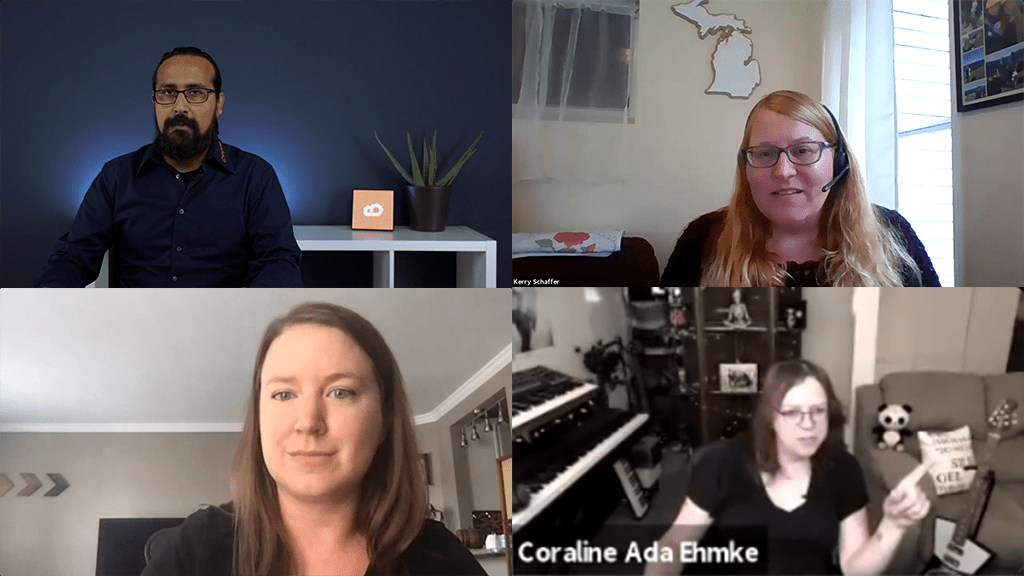 Martín Valencia Flores, Kerry Schaffer, Stacy Kirkland, Coraline Ada Ehmke
Martín Valencia Flores, Kerry Schaffer, Stacy Kirkland, Coraline Ada Ehmke- “We’re all inspired by the promise of free and open, but we also need to accept responsibility for impact and outcomes.” —Coraline Ada Ehmke, the Organization for Ethical Source
- “By prioritizing the customer rather than rushing to complete the migration, we were able to successfully complete the migration with no impact to the business.” —Stacy Kirkland, Liberty Mutual
- “By performing the dirty snap during working hours and the majority of the migration happening before the impactful change window, we helped to shift the culture of management.” —Stacy Kirkland, Liberty Mutual
Want more from the summit? The video recordings of the sessions are already available on the Cloud Foundry Foundation’s YouTube channel. You can also check out highlights of the event by using the #CFSummit hashtag on Twitter.




